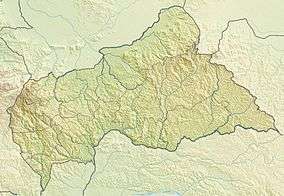Dzanga-Ndoki National Park
The Dzanga-Ndoki National Park is located in the southwestern extremity of the Central African Republic. Established in 1990, the national park is 1,143.26 square kilometres (441.42 sq mi).[1] The national park is split into two non-continuous sectors, the northern Dzanga sector (or Dzanga Park) 49,500 ha (122,000 acres) and the southern Ndoki sector (or Ndoki Park)[2] 72,500 ha (179,000 acres). Notable in the Dzanga sector is a gorilla density of 1.6/km2 (4.1/sq mi), one of the highest densities ever reported for the western lowland gorilla.[3]
| Dzanga-Ndoki National Park | |
|---|---|
IUCN category II (national park) | |
 Location in Central African Republic | |
| Location | |
| Nearest city | Nola |
| Coordinates | 2°30′N 16°10′E |
| Area | 1,143.26 km2 (441.42 sq mi) |
| Established | 1990 |
Between the two sectors of the national park stretches the Dzanga-Sangha Special Reserve 335,900 ha (830,000 acres). The national park and the special reserve, each with its own protective status, are a part of the Dzanga-Sangha Complex of Protected Areas (DSPAC).[4][5]
Geography

The Dzanga-Sangha National Park is located in the extreme southwest of the Central African Republic in a triangular-shaped part of the country. The main river running through this region is the Sangha River.[6] The precise border between the Central African Republic, Cameroon and the Republic of the Congo is located at 2°13′14″N 16°11′31″E (in the Sangha River), marking the furthest point of the park to the southwest.
The park's altitude ranges from 340 to 615 m (1,115 to 2,018 ft) above sea level. The whole park is on alluvial sands. Along streams, forest clearings can be found with marshy depressions referred to as 'bai'.[7] The Dzanga Bai (translation: "the village of elephants") is a sandy salt lick that measures 250 by 500 m (820 by 1,640 ft). It is traversed through the middle by the Dzanga, a stream.[4][8] Since 1997, Bai Hokou has the base site of the Primate Habituation Programme where gorilla habituation for tourism has been ongoing, along with research.[9]
Logging occurred in the 1980s in the Dzanga sector but not in the Ndoki which is primary forest.[7] Amis Kamiss wrote in 2006 of having visited fifteen diamond mining sites in the Lobé River region, located in the northwestern part of the national park.[10]
Fauna and flora
There are three types of forest within Dzanga-Ndoki National Park: mainly dryland, a semi-evergreen forest that contains swamp-forest areas along the rivers and, a closed-canopy, monodominant Gilbertiodendron dewevrei forest. The dryland forest is an open, mixed canopy that is dominated by Sterculiaceae and Ulmaceae; often associated with it is a dense understorey of Marantaceae and Zingiberaceae. Along the Sangha River, there are stands of Guibourtia demeusii.
There are several intact populations of key forest fauna including the western lowland gorilla, African forest elephant, chimpanzee, giant forest hog, red river hog, sitatunga, endangered bongo,[11] African forest buffalo, and six species of duiker.[12] The gorilla density of 1.6 individuals/km2 within the Dzanga sector is one of the highest densities ever reported for the western lowland gorilla.[3]
The Dzanga-Ndoki National Park has been designated an Important Bird Area (#CF008). The IBA is contiguous with two other IBAs, Lobéké of Cameroon (#CM033) and Nouabalé-Ndoki in Congo (#CG001). Over 350 bird species have been reported at the national park of which at least 260 can be expected to breed. Stiphrornis sanghensis has been described as a new species noted only within Dzanga-Sangha, but further investigation is pending[7] as it may also occur in adjacent parts of Democratic Republic of the Congo, Cameroon and Republic of the Congo.[13]
In May 2013, the slaughtering of 26 African forest elephants by poachers in Dzanga Bai, a reserve in the world heritage site Sangha Trinational[14] led to worldwide concern by conservationists.[15]
References
- World Database on Protected Areas
- Riley, Laura; Riley, William (2005). Nature's strongholds: the world's great wildlife reserves. Princeton University Press. p. 42. ISBN 0-691-12219-9.
- Almasi, A.; Blom, A.; Heitkönig, I.M.A.; Kpanou, J.B.; Prins, H.H.T. (2001). "A survey of the apes in the Dzanga-Ndoki National Park, Central African Republic: A comparison between the census and survey methods of estimating the gorilla (Gorilla gorilla gorilla) and chimpanzee (Pan troglodytes) nest group density". African Journal of Ecology. 39: 98–105. doi:10.1046/j.0141-6707.2000.00280.x. ISSN 0141-6707.
- "Central African Republic". Africa's Eden. Archived from the original on 27 March 2010. Retrieved 18 September 2010.
- Balinga, Michael; Moses, Sainge; Fombod, Eunice (August 2006). "A Preliminary Assessment of the Vegetation of the Dzanga Sangha Protected Area Complex, Central Africa Republic" (PDF). World Wildlife Fund, Smithsonian Institution. pp. 6–7. Retrieved 18 September 2010.
- "The Sangha River Tri-national Protected Area (STN)". Dzanga-Sangha. Retrieved 18 September 2010.
- "BirdLife IBA Factsheet CF008 Dzanga-Ndoki National Park". Downloaded from the Data Zone at http://www.birdlife.org. BirdLife International. Retrieved 19 September 2010. External link in
|work=(help) - Kamiss, Amis; Turkalo, Andrea K. (30 November 1999). "Elephant Crop Raiding in the Dzanga-Sangha Reserve, Central African Republic" (PDF). The African Elephant Specialist Group (AfESG). p. 2.
- "Field research". Max Planck Institute for Evolutionary Anthropology, Department of Primatology. Archived from the original on 19 October 2010. Retrieved 19 September 2010.
- Chupezi, Tieguhong Julius; Ingram, Verina; Schure, Jolien. Impacts of artisanal gold and diamond mining on livelihoods and the environment in the Sangha Tri-National Park landscape. CIFOR. p. 31. ISBN 978-602-8693-14-1.
- "The endangered bongo antelope in Dzanga Ndoki National Park Central". Encyclopædia Britannica. Retrieved 19 September 2010.
- "Dzangandoki". dzangandoki.com. Archived from the original on 7 February 2011. Retrieved 19 September 2010.
- BirdLife International (2006). "Stiphrornis erythrothorax". IUCN Red List of Threatened Species. 2006. Retrieved 27 September 2008.CS1 maint: ref=harv (link)
- World Heritage Site: Sangha Trinational
- Welch, Adam (10 May 2013). "Poachers kill 26 elephants at central African world heritage site". The Guardian. Retrieved 22 June 2013.